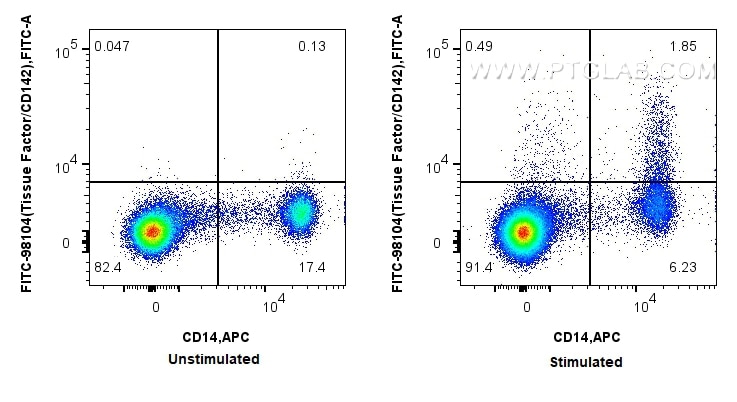Tested Applications
| Positive FC detected in | LPS treated human PBMCs |
Recommended dilution
| Application | Dilution |
|---|---|
| This reagent has been pre-titrated and tested for flow cytometric analysis. The suggested use of this reagent is 5 ul per 10^6 cells in a 100 µl suspension or 5 ul per 100 µl of whole blood. | |
| Sample-dependent, Check data in validation data gallery. | |
Product Information
FITC-98104 targets Tissue Factor/CD142 in FC applications and shows reactivity with human samples.
| Tested Reactivity | human |
| Host / Isotype | Rabbit / IgG |
| Class | Recombinant |
| Type | Antibody |
| Immunogen | Recombinant protein Predict reactive species |
| Full Name | coagulation factor III (thromboplastin, tissue factor) |
| Calculated Molecular Weight | 33 kDa |
| GenBank Accession Number | NM_001993.5 |
| Gene Symbol | F3 |
| Gene ID (NCBI) | 2152 |
| Conjugate | FITC Plus Fluorescent Dye |
| Excitation/Emission Maxima Wavelengths | 495 nm / 524 nm |
| Form | Liquid |
| Purification Method | Protein A purification |
| UNIPROT ID | P13726-1 |
| Storage Buffer | PBS with 0.09% sodium azide and 0.5% BSA. |
| Storage Conditions | Store at 2-8°C. Avoid exposure to light. Stable for one year after shipment. |
Background Information
Normal blood coagulation is a complex process, involving a cascade of activation of different plasma proteins, ultimately resulting in the formation of a clot, called fibrin. Tissue Factor (TF), also named CD142, coagulation factor III or F3, is the primary initiator of the blood coagulation cascade and plays an essential role in hemostasis (PMID: 26877187; PMID: 33796108).
Protocols
| Product Specific Protocols | |
|---|---|
| FC protocol for FITC Plus Tissue Factor/CD142 antibody FITC-98104 | Download protocol |
| Standard Protocols | |
|---|---|
| Click here to view our Standard Protocols |



